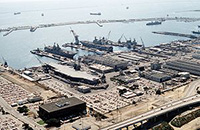Long Beach Naval Shipyard
Long Beach Naval Shipyard, which was officially closed in 1997, was given its current name in 1948. The installation was previously known as Terminal Island Naval Shipyard and the U.S. Naval Dry Docks, Roosevelt Base, California.

Written by Aaron Munz • Edited By Walter Pacheco
Asbestos.com is the nation’s most trusted mesothelioma resource
The Mesothelioma Center at Asbestos.com has provided patients and their loved ones the most updated and reliable information on mesothelioma and asbestos exposure since 2006.
Our team of Patient Advocates includes a medical doctor, a registered nurse, health services administrators, veterans, VA-accredited Claims Agents, an oncology patient navigator and hospice care expert. Their combined expertise means we help any mesothelioma patient or loved one through every step of their cancer journey.
More than 30 contributors, including mesothelioma doctors, survivors, health care professionals and other experts, have peer-reviewed our website and written unique research-driven articles to ensure you get the highest-quality medical and health information.
About The Mesothelioma Center at Asbestos.com
- Assisting mesothelioma patients and their loved ones since 2006.
- Helps more than 50% of mesothelioma patients diagnosed annually in the U.S.
- A+ rating from the Better Business Bureau.
- 5-star reviewed mesothelioma and support organization.
Testimonials
My family has only the highest compliment for the assistance and support that we received from The Mesothelioma Center. This is a staff of compassionate and knowledgeable individuals who respect what your family is experiencing and who go the extra mile to make an unfortunate diagnosis less stressful. Information and assistance were provided by The Mesothelioma Center at no cost to our family.LashawnMesothelioma patient’s daughter
How to Cite Asbestos.com’s Article
APA
Munz, A. (2023, June 20). Long Beach Naval Shipyard. Asbestos.com. Retrieved April 19, 2024, from https://www.asbestos.com/shipyards/long-beach-naval/
MLA
Munz, Aaron. "Long Beach Naval Shipyard." Asbestos.com, 20 Jun 2023, https://www.asbestos.com/shipyards/long-beach-naval/.
Chicago
Munz, Aaron. "Long Beach Naval Shipyard." Asbestos.com. Last modified June 20, 2023. https://www.asbestos.com/shipyards/long-beach-naval/.
The facility was designated as a repair location for surface ships. The shipyard had onsite facilities to perform all non-structural repairs, including boiler, rigging, electrical, lagging, sandblasting, welding, machining, woodworking, painting and pipe fitting. During World War II, the dry docks provided both routine and damage repairs to tankers, cargo ships, troop transports, destroyers and cruisers.
A large majority of the operations at this shipyard and others involved exposure to asbestos-contaminated materials, including pipe fitting, lagging sandblasting, machining, maintenance and working with boilers and other hot materials. Spray-on asbestos was also applied to many parts of a vessel, even sleeping quarters.
As a result of this extensive asbestos usage in shipyards, numerous workers and Navy personnel have developed asbestos-related diseases such as mesothelioma, asbestosis and lung cancer. Many of these workers were exposed to moderate and high concentrations of asbestos.
A 2021 review of the risk of asbestos-related cancer among sailors was published in the International Journal of Environmental Health Research. It presented a 2020 study on seafarers from five Nordic countries who have more than double the risk of developing mesothelioma compared to the general public.
In 2017, a report was published in the Archives of Environmental & Occupational Health that studied shipyard workers exposed to moderate and high levels of asbestos. Those exposed to moderate levels of asbestos were about four times more likely to die of mesothelioma. Workers exposed to high levels were more than seven times more likely to get mesothelioma.
Asbestos Exposure at Long Beach Naval Shipyard
Many workers at the Long Beach Naval Shipyard were exposed to high levels of asbestos fibers. In a study documented in 1979, 6,640 employees, or about 88 percent of the total number of staff members, underwent a chest X-ray to determine if they had developed any abnormalities as a result of their exposure.
The researchers who reviewed the results of these X-rays observed that:
- Abnormal findings that were the result of inhaling asbestos fibers were present on the chest X-rays of 1,061 workers.
- Pulmonary fibrosis – a condition in which scar tissue builds up in the lungs, making them stiff and unable to properly function – was found in 140 employees.
- About 17 percent of the male employees and less than 1 percent of the female employees had chest X-rays that indicated abnormalities resulting from inhaling asbestos.
- Only about 1 percent of all employees between the ages of 25 to 29 had asbestos-related abnormalities, while approximately 38 percent of workers 65 years old and older had asbestos-related abnormalities.
- Only about 12 percent of the employees who had worked at the facility between two to six years had chest X-ray abnormalities, while 37 percent of employees who had worked there between 22 to 26 years had abnormalities. The researchers did specify that although the shipyard was in operation between 1943 and 1949, the system of assigning badge numbers to employees made it impossible to include those years in the work history of persons who had had at least 26 years of service.
- Approximately 11 percent of all production workers that participated in the study had X-rays that were positive for asbestos-related abnormalities, while about 4 percent of non-production workers (administrative) had positive X-rays.
- The total population that had positive chest X-rays amounted to 16 percent of all workers who participated in the study.

Cleaning Up Long Beach Naval Complex
In a January 2010 report, the Navy explained what had been done to clean up the various contaminants, including asbestos that was found at that location known as the Long Beach Naval Complex, which was made up of the former Naval Station Long Beach and the former Long Beach Naval Shipyard.
These uncovered contaminants were typically found at bases that built and serviced ships, and included “solid and liquid waste disposal, chemical storage, ship manufacturing, degreasing, paint removal, dry cleaning, electrical and weapons shop operations, fueling operations, and other industrial activities.”
The Navy’s solutions involved dealing with the removal of these contaminants as specified in their own Records of Decision for Installation Restoration (IR) Sites, which were endorsed by two divisions of the California Environmental Protection Agency.







